story and photos by Kayte Deioma
Whereas the other three museums are very Southwest oriented, this unprecedented collection of international folk art seems to have found an unlikely home in this high desert capital of about 65,000 inhabitants. As the beneficiary of two extensive personal folk art collections, Santa Fe’s Museum of International Folk Art now has the most extensive folk art collection in the world.
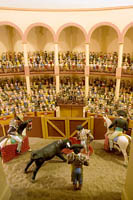 The Girard Wing contains a small sample of the 100,000 pieces donated by famed architect and designer Alexander Girard, who also designed the exhibit, Multiple Visions: A Common Bond, which is the definition of delightful. 10,000 colorful folk-art figures that he and his wife collected from 100 different countries on six continents are displayed in a context of miniature rooms, houses, churches, castles, villages and towns. Each display is a treat to behold. Hundreds of tiny spectators watch a bullfight in “Plaza de Toros”. Musicians play and uniformed cavalry ride as dozens of miniature pilgrims climb a long staircase in a display of 1930s decorative ceramics by Ana Das Telas and three other women from Estremoz, Portugal.
The Girard Wing contains a small sample of the 100,000 pieces donated by famed architect and designer Alexander Girard, who also designed the exhibit, Multiple Visions: A Common Bond, which is the definition of delightful. 10,000 colorful folk-art figures that he and his wife collected from 100 different countries on six continents are displayed in a context of miniature rooms, houses, churches, castles, villages and towns. Each display is a treat to behold. Hundreds of tiny spectators watch a bullfight in “Plaza de Toros”. Musicians play and uniformed cavalry ride as dozens of miniature pilgrims climb a long staircase in a display of 1930s decorative ceramics by Ana Das Telas and three other women from Estremoz, Portugal.
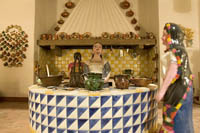 Women in Mexican garb make tiny enchiladas on a horseshoe shaped counter in a kitchen filled with miniscule clay pots, tin utensils and copper pans hanging above the brazero fireplace. Girard created the display based on a colonial kitchen he had seen in Mexico. A door off of the kitchen leads to a sala where a man plays a violin and light shines in from an interior courtyard.
Women in Mexican garb make tiny enchiladas on a horseshoe shaped counter in a kitchen filled with miniscule clay pots, tin utensils and copper pans hanging above the brazero fireplace. Girard created the display based on a colonial kitchen he had seen in Mexico. A door off of the kitchen leads to a sala where a man plays a violin and light shines in from an interior courtyard.
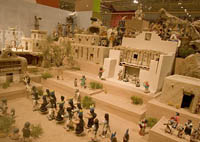 In “Pueblo Feast Day,” children play among adobe houses and tourists take photos as adult figures dance the corn dance below with kachina spirit dancers and eagle dancers on the mesa above. This exhibit contains the most famous piece of art in the gallery. Helen Cordero, a Cochiti Indian and Alexander Girard collaborated on the design of the first “storyteller” figure created by a New Mexico Pueblo artist. “Storyteller” figures of a seated woman with multiple children sitting or climbing on her have become ubiquitous in earthenware work.
In “Pueblo Feast Day,” children play among adobe houses and tourists take photos as adult figures dance the corn dance below with kachina spirit dancers and eagle dancers on the mesa above. This exhibit contains the most famous piece of art in the gallery. Helen Cordero, a Cochiti Indian and Alexander Girard collaborated on the design of the first “storyteller” figure created by a New Mexico Pueblo artist. “Storyteller” figures of a seated woman with multiple children sitting or climbing on her have become ubiquitous in earthenware work.
Scores of colorful clay figures from two to six inches tall populate a ” Mexican Village” created to represent the village of Puebla. The town has cathedrals in varying sizes to match its multi-sized population. Many of the larger pieces were made by Herón Martinez Mendoza, one of Mexico’s most respected potters from Acatlan, a pottery making center.
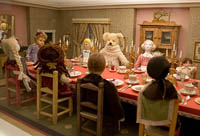 In “Doll’s Christmas Lunch” a teddy bear in a turtleneck and a couple pilgrims sit down to a fancy dinner with the other assorted interntaional residents of a Victorian doll house. East Indian puppets from Rajastan with black beards and mustaches painted on their carved wooden heads mingle with various Hindu gods and mythological figures in and around a multi-storied palace in “Indian Street Scene.” The marionettes are draped in elaborate gilded costumes.
In “Doll’s Christmas Lunch” a teddy bear in a turtleneck and a couple pilgrims sit down to a fancy dinner with the other assorted interntaional residents of a Victorian doll house. East Indian puppets from Rajastan with black beards and mustaches painted on their carved wooden heads mingle with various Hindu gods and mythological figures in and around a multi-storied palace in “Indian Street Scene.” The marionettes are draped in elaborate gilded costumes.
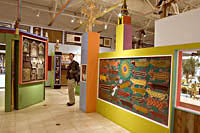 These vibrant daily-life and story-book scenes are interspersed with displays of masks, toys, paintings, costumes, ornate woven story panels and other colorful textiles, providing a constant flow of eye-candy. There are no captions on the displays, so be sure to pick up the spiral-bound guide to the Girard exhibit available at the entrance to be able to identify specific displays.
These vibrant daily-life and story-book scenes are interspersed with displays of masks, toys, paintings, costumes, ornate woven story panels and other colorful textiles, providing a constant flow of eye-candy. There are no captions on the displays, so be sure to pick up the spiral-bound guide to the Girard exhibit available at the entrance to be able to identify specific displays.
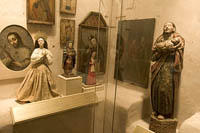 Another permanent exhibit is the Familia y Fe/Family and Faith exhibit in the Hispanic Heritage Wing. The exhibit features pieces from the Museum’s New Mexico Hispanic folk art collection including religious and household objects. The artistry of furniture making and woven textiles are juxtaposed with the religious retablos (paintings) andbultos (wooden sculptures) that have been used both in the home and for ceremonial purposes since the 17 th century.
Another permanent exhibit is the Familia y Fe/Family and Faith exhibit in the Hispanic Heritage Wing. The exhibit features pieces from the Museum’s New Mexico Hispanic folk art collection including religious and household objects. The artistry of furniture making and woven textiles are juxtaposed with the religious retablos (paintings) andbultos (wooden sculptures) that have been used both in the home and for ceremonial purposes since the 17 th century.
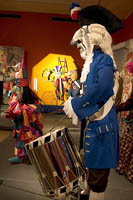 Through August 2005, the Museum is hosting the traveling exhibit ĄCARNAVAL! About 50 festively costumed manikins step out of life-size photos representing select carnival traditions of Bolivia, Brazil, Italy, Mexico, Spain, Switzerland, Trinidad and Tobago and the USA. Accompanying video clips of the each celebration bring the tableaus alive.
Through August 2005, the Museum is hosting the traveling exhibit ĄCARNAVAL! About 50 festively costumed manikins step out of life-size photos representing select carnival traditions of Bolivia, Brazil, Italy, Mexico, Spain, Switzerland, Trinidad and Tobago and the USA. Accompanying video clips of the each celebration bring the tableaus alive.
The Museum and other local arts 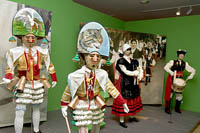 and entertainment organizations are hosting a variety of carnival-themed events throughout the exhibit. Highlights include a Brazilian entertainment weekend at the Museum June 25-26, a Swiss Carnival weekend July 23-24 and a Mexican weekend August 13-14. For more related events including music, arts and crafts workshops and cooking classes visitwww.carnivalsantafe.com.
and entertainment organizations are hosting a variety of carnival-themed events throughout the exhibit. Highlights include a Brazilian entertainment weekend at the Museum June 25-26, a Swiss Carnival weekend July 23-24 and a Mexican weekend August 13-14. For more related events including music, arts and crafts workshops and cooking classes visitwww.carnivalsantafe.com.
There is a children’s playroom near the lobby of the Museum where kids can play while parents explore the touch-me-not displays. I didn’t have time to go downstairs where adults can get hands-on with some of the items in the Museum’s collection.
The pilgrimage to the Museum of New Mexico continues: Museum of Fine Arts, The Museum of Indian Arts and Culture and The Palace of the Governors.
For more information on the Museum of International Folk Arts, visit www.moifa.org.
